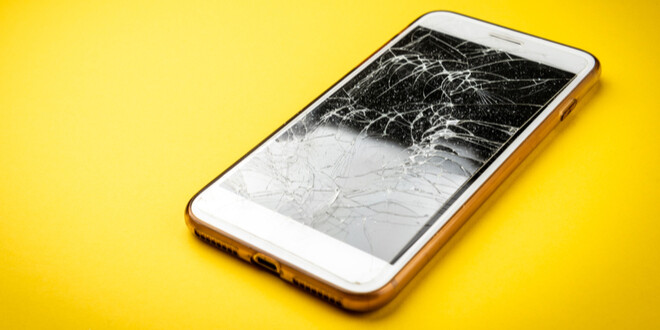SELF-REPAIRING ELECTRONICS ARE ON THE WAY, THANKS TO HAIFA SCIENTISTS
BY JUDY SIEGEL-ITZKOVICH | JAN 2, 2022 | MEDICAL/SCIENCE

Broken glass screen smartphone (Shutterstock)
Share this article
Owners of homes and electrical devices that fill them as well as cars and other property often feel that they spend much of their time getting things fixed, as objects tend to wear and break down. In an ideal world, the cracked screen of your mobile phone would heal itself overnight or the solar panels providing energy to satellites could continually fix the damage caused by micro-meteorites.
Science-fiction authors often write stories about self-repairing robots and other devices, but in reality, electronic devices eventually need to be replaced.
Group photo. L-R: Prof. Yehonadav Bekenstein, Sasha Khalfin and Noam Veber
Credit : Rami Shelush
The field of self-repairing materials is speedily expanding, and what used to be science fiction might soon become reality, thanks to scientists at the Technion-Israel Institute of Technology in Haifa who developed eco-friendly nanocrystal semiconductors capable of self-healing.
Their findings, recently published in Advanced Functional Materials under the title “Self-Healing of Crystal Voids in Double Perovskite Nanocrystals Is Related to Surface Passivation,” describe the process in which a group of materials called double perovskites displays self-healing properties after being damaged by the radiation of an electron beam.
Perovskites are a calcium titanium oxide mineral composed of calcium titanate. The mineral was discovered in the Ural Mountains of Russia in by Gustav Rose in 1839 and is named after 19th-century Russian mineralogist Lev Perovski. Perovskites have sub-metallic to metallic luster, a colorless streak and cube-like structure along with imperfect cleavage and brittle tenacity. Colors include black, brown, gray, orange to yellow.
They have attracted scientists’ attention in recent years because of their unique electro-optical characteristics that make them highly efficient in energy conversion even though they are inexpensive to produce. A special effort has been put into the use of lead-based perovskites in highly efficient solar cells.
The Technion research group of Prof. Yehonadav Bekenstein from the Technion’s Faculty of Material Sciences and Engineering and the Solid-State Institute is looking for green alternatives to the toxic lead and engineering lead-free perovskites. The team specializes in the synthesis of nano-scale crystals of new materials. By controlling the crystals’ composition, shape, and size, they change the material’s physical properties.
Bekenstein completed his degrees in physics and chemistry at the Hebrew University of Jerusalem. After a postdoctoral fellowship at the University of California at Berkeley, he joined the Technion faculty in 2018. He has received multiple awards, and two years ago, he was awarded the ERC Starting Grant for early-career scientists.
Nanocrystals are the smallest material particles that remain naturally stable. Their size makes certain properties more pronounced and enables research approaches that would be impossible on larger crystals, such as imaging using electron microscopy to see how atoms in the materials move. This was, in fact, the method that enabled the discovery of self-repair in the lead-free perovskites.
The perovskite nanoparticles were produced in Bekenstein’s lab using a short, simple process that involves heating the material to 100° Celsius for a few minutes. When doctoral students Sasha Khalfin and Noam Veber examined the particles using a transmission electron microscope, they discovered the exciting phenomenon. The high voltage electron beam used by this type of microscope caused faults and holes in the nanocrystals. The researchers were then able to explore how these holes interact with the material surrounding them and move and transform within it.
They saw that the holes moved freely within the nanocrystal, but avoided its edges. The researchers developed a code that analyzed dozens of videos made using the electron microscope to understand the movement dynamics within the crystal.
They found that holes formed on the surface of the nanoparticles and then moved to energetically stable areas inside. The reason for the holes’ movement inwards was hypothesized to be organic molecules coating the nanocrystals’ surface. Once these organic molecules were removed, the group discovered the crystal spontaneously ejected the holes to the surface and out, returning to its original pristine structure – in other words, the crustal repaired itself.
This discovery is an important step towards understanding the processes that enable perovskite nanoparticles to heal themselves, and paves the way to their incorporation in solar panels and other electronic devices.

